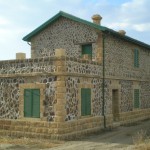Ένα από τα σημαντικά γεγονότα που σημάδεψαν την παραμονή των Άγγλων στη διάρκεια της παρουσίας τους στην Κύπρο – 1878 – 1960 – είναι και η λειτουργία του σιδηροδρόμου, το 1905 –1951.
Το οδικό δίκτυο της Κύπρου ουσιαστικά ανύπαρκτο. Δρόμοι – αμαξωτοί – υπήρχαν για να συνδέουν τις πόλεις και πολύ λίγα χωριά, ιδιαίτερα δε στις περιοχές που εξυπηρετούσαν τις κατοχικές αρχές. Έξω από αυτές τις περιοχές είναι τα μονοπάτια, όπου όλες οι εργασίες – μεταφοράς αγαθών άλλα και ανθρώπων, γινόντουσαν με τα γαϊδούρια και τ’ αμάξια. Κκιρατζήδες και Αμαξάρηδες.
Για την αντιμετώπιση των αυξανόμενων απαιτήσεων στη διακίνηση αγαθών, αλλά και ανθρώπων, ήταν απαραίτητη η βελτίωση του οδικού δικτύου. Η δημιουργία νέων δρόμων για τροχοφόρα μηχανοκίνητα, όπως και η κατασκευή σιδηροδρόμου, για να συνδέει ένα λιμάνι με βασικές αγροτικές περιοχές, αλλά και τα μεταλλεία Σκουριώτισσας και Χρωμίου, ήταν έργα παραπάνω από απαραίτητα.
Έτσι στις 21 Οκτωβρίου 1905, έγιναν τα εγκαίνια, στην Αμμόχωστο, της πρώτης γραμμής μέχρι τη Λευκωσία και το 1907 μέχρι και τη Μόρφου, για να φτάσει στον τελικό σταθμό στη Σκουριώτισσα και την Ευρύχου, το 1915. Εκεί που σώζονται τα χαλάσματα ενός πετρόκτιστου κτιρίου, ήταν ο τελευταίος σταθμός του κυπριακού σιδηρόδρομου. Αυτός κτίστηκε το 1906.
Σ’ αυτή την περιοχή, είχαν κτιστεί διάφορα υποστατικά, για την εξυπηρέτηση της καλής λειτουργίας του σιδηροδρόμου. Γραφεία, αίθουσα επιβατών, μηχανοστάσιο, αποθήκες εμπορευμάτων και ένας ξενώνας “ξενοδοχείο”, για τη διανυκτέρευση επιβατών και περιηγητών.
Η ύπαρξη ενός τέτοιου έργου σ’ αυτή την περιοχή, εκτός από τις διευκολύνσεις στη διακίνηση αγαθών και ανθρώπων, ήταν και μέσο για απασχόληση – εργοδότηση εργαζομένων – κάτι που συνέβαλε πάρα πολύ και στην ανάπτυξη του χωριού.
Σταδιακά άρχισαν ν’ αναπτύσσονται τα διάφορα επαγγέλματα και βιοτεχνίες.
Επιπλοποιοί, ράπτες, υποδηματοποιοί, σιδεράδες, μικροέμποροι, αμαξάρηδες, αγωγιάτες κ.λ.π. Κέντρα αναψυχής, καφενεία, ταβέρνες, κύρια χαρακτηριστικά, που ξεχώριζαν το χωριό απ’ όλα τα άλλα χωριά της περιοχής.
Εδώ βρισκόταν ο αστυνομικός σταθμός, κτηματολόγιο, δικαστήριο. Εδώ ιδρύθηκε και η Ελληνική Σχολή. Ζωή και κίνηση ολόκληρο το εικοσιτετράωρο.
Η ύπαρξη της σχολής στην Ευρύχου, έδινε τη δυνατότητα για την κινητοποίηση και τον φρονηματισμό των κατοίκων της περιοχής, έτσι τον Οκτώβρη του 1931 όταν ξέσπασε στη Κύπρο εξέγερση ενάντια στην αγγλική κατοχή, το χωριό διαδραμάτισε το δικό του ρόλο.
Η λειτουργία του σιδηρόδρομου τερματίστηκε στις 31.12.1931. Θεωρήθηκε σαν τιμωρία, για τη συμπεριφορά των χωριανών ενάντια των εγγλέζων, παρά το δικαιολογητικό για ασύμφορο έργο.
Το τραίνο σταμάτησε να τρέχει. Σταμάτησε να εξυπηρετεί την περιοχή. Οι θύμησες όμως, παραμένουν ζωντανές, η ιστορία καταγράφει και εμείς τη βοηθούμε να καταγράφει και να κρατά ζωντανές τις μνήμες, για ν’ αντέχουν στη φθορά του χρόνου.
Από εδώ πηγάζει η ευθύνη, το καθήκον μας, να προσπαθούμε να μη μείνει έτσι όπως είναι σήμερα αυτό το ερείπιο, που κάποτε ήταν ιστορικό γεγονός, ο σταθμός του σιδηρόδρομου της Κύπρου.
Για την ιστορία αναφέρουμε ότι αυτό το κτίριο χρησιμοποιήθηκε το 1932 σαν υγειονομικό κέντρο, λόγω και της τοποθεσίας, για αντιμετώπιση μεταδοτικής ασθένειας. Αργότερα σαν κοιτώνας δασικών λειτουργών και καταστράφηκε το 1957.
Ύστερα από διαβήματα της Κοινοτικής Αρχής αλλά και αρκετών δημοσιευμάτων, ανακοινώθηκε τον περασμένο χρόνο – Σεπτέμβρης 2003 – έγκριση ποσού £ 24.000, για αναπαλαίωση αυτού του κτιρίου.
Μέχρι σήμερα, Μάης 2004, δεν έχει γίνει τίποτε, κι’ αυτό πρέπει να μας ανησυχεί να δραστηριοποιηθούμε και να απαιτούμε διαρκώς την αξιοποίηση του χώρου και της ιστορίας του.
Η τοποθέτηση ξύλινης επιγραφής, Τμήμα Αρχαιοτήτων, δεν είναι αρκετή. Ο δρόμος που οδηγεί προς το κτίριο αυτό, να γίνει πλακόστρωτος το συντομότερο, έστω και με δαπάνες του χωριού.
12/05/04 Θ.Κ.
